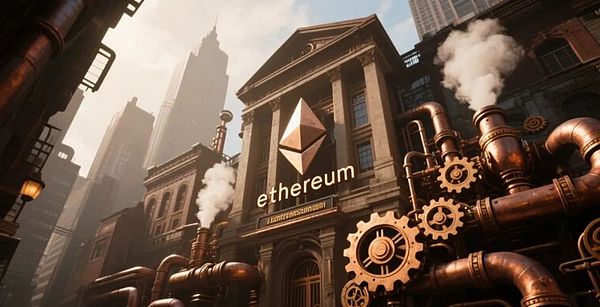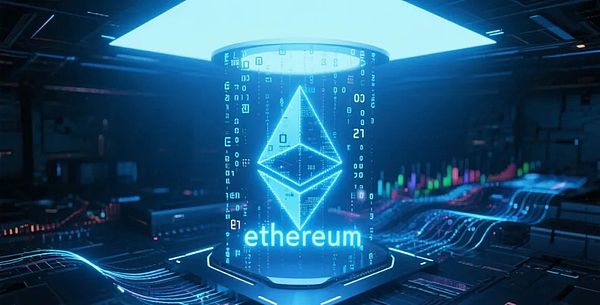A war for assets without gunpowder has quietly begun, and global listed companies are hoarding Ethereum at an unprecedented rate.
In July 2025, an investment announcement by PayPal co-founder Peter Thiel shocked the crypto market - he held a 9.1% stake in mining company BitMine through his entity, and the company has transformed its Ethereum financial strategy, holding 300,700, becoming the world's largest ETH reserve listed company.

This is just the tip of the iceberg. Driven by companies such as SharpLink Gaming and Bit Digita,more than 85 listed companies have included Ethereum in their balance sheets, holding a total of about 1.6 million ETH, accounting for 1.9% of the total circulation.
1. Positioning evolution: from "world computer" to "world ledger"
The ten-year development history of Ethereum is a history of continuous self-innovation. Founder Vitalik Buterin recently redefined its positioning: "The first layer of Ethereum is the world's ledger", which marks the shift of its strategic focus from an all-round computing platform to financial infrastructure. In the early days, Ethereum had the vision of building a "world computer" and hoped to become an open platform for running various smart contracts, but practical challenges followed one after another: high gas fees and limited TPS performance made it difficult for complex computing applications to be implemented on a large scale. "The main goal of Ethereum in the first ten years was to do a good job of Ethereum technology," said co-founder Vitalik Buterin at the 2024 Blockchain Global Summit. In the past ten years, Ethereum has undergone a transformation from a proof of concept to a production engine.

The turning point came with the maturity of Rollup technology in 2020. This pushed Ethereum to form a layered architecture of "L1+L2": the main network focuses on security and final settlement, while the Layer2 network carries high-frequency transactions.This division of labor has naturally evolved the Ethereum main network into a global decentralized ledger.
The implementation of EIP-1559 is a key mechanism for value capture. By introducing the Base Fee and burning mechanism, L2 will destroy ETH when each transaction returns to the main network for verification, which is equivalent to paying for the security of the ledger. When the network is active, ETH even presents deflationary properties, reshaping its value support logic.
2. Technology Roadmap: Five major upgrades build the cornerstone of the future
The technology upgrade route is clear: from Homestead in 2016 to the London upgrade in 2021, each hard fork has pushed the network forward. The "Merge" in September 2022 has become a milestone event.
Ethereum's transition from PoW to PoS consensus mechanism has laid the foundation for subsequent development.
In 2024, the Ethereum transaction experience will undergo a qualitative change. Vitalik revealed in his speech: "The transaction fee will drop from US$5-10 in 2021 to US$0.01, and the transaction confirmation speed will be shortened from minutes to seconds". These improvements make Ethereum truly capable of serving the general public .
At present, the Ethereum pledge ecosystem is booming. Data shows that the total network pledge volume has exceeded 35 million ETH, accounting for more than 29% of the circulation, and the annual release value exceeds US$1 billion. This pledge economy has become an important attraction for companies to configure ETH.
The future technology roadmap is even more exciting. The Prague Upgrade in 2025 will introduce the Proof of Stake Plus consensus mechanism and dynamic sharding technology.

Ethereum's technical roadmap for the next two years is laying a solid foundation for its role as the "world ledger".
The five major technical directions include:1.zkEVM Layer1 integration (2025Q4-2026Q2): Zero-knowledge proof verification costs are reduced by 80%, and 99% of blocks are verified within 10 seconds. This will attract stablecoins such as USDC and USDT to expand their main chain share and directly promote ETH deflation.
2.RISC-V execution new architecture (launched in the second half of 2025): Using open source instruction sets to replace traditional EVM, the efficiency of smart contract execution is increased by 3-5 times, and the Gas cost is reduced by 50-70%. This will activate new application scenarios such as high-frequency trading and real-time games.
3.L1-L2 ecological synergy (launched in Q4 2025): The goal is to break through the TVL of the unified liquidity pool of US$200 billion (currently about 120 billion), reduce cross-layer transaction costs by 90%, and achieve cross-layer confirmation within 10 seconds. The DeFi protocol will aggregate the liquidity of the entire ecosystem and achieve a leap in capital efficiency.
4. Validator economic optimization (starting in the second half of 2025): The staking threshold will be gradually reduced from 32 ETH to 1 ETH, and the annualized rate of return will be increased to 6-8%. This will push the ETH staking rate from 25% to more than 40%, and about 48 million ETH will be locked.
5. Sharding technology returns (ETH 3.0, after 2026): Combining zkEVM and sharding to achieve millions of TPS, and reduce data availability costs by 99%. This paves the way for large-scale application of Web3 in the next decade.

By 2030, the Ethereum technology stack will be fully upgraded, and the execution layer will introduce RISC-V virtual machine, which will increase efficiency by 50-100 times; the settlement layer will implement native Rollup through the EXECUTE pre-compilation function, allowing L1 to directly verify L2 execution.
3. Enterprise reserve arms race: capital structure reconstruction
The wave of enterprises incorporating Ethereum into their balance sheets is reshaping the capital structure. The core driving factors of this trend are clearly visible:
1. Staking income: 3-5% annualized income allows companies to generate returns on idle funds
2. Ecological participation: Deeply participate in innovative fields such as DeFi and tokenization through ETH
3. Asset deflation: Supply contraction under the EIP-1559 mechanism brings expected value-added 4. Market confidence: Convey a corporate image of embracing technological innovation to investors The ranking of corporate ETH holdings in 2025 reveals a new pattern: 1. Bitmine Immersion (stock code: BMNR) ETH holdings: 300,700 pieces left;">Latest News: Through private placement financing of US$250 million (approximately 81,380 ETH), the company significantly increased its holdings, and its total holdings jumped to the first place. The company is mainly engaged in blockchain infrastructure (such as mining farm operations and hardware sales), but has not yet disclosed its ETH staking plan
Strategy features: Pure equity financing, avoiding debt risks, but significant equity dilution (share capital increased 13 times)
2. SharpLink Gaming (stock code: SBET)
ETH holdings: 280,600
Latest developments:Through a combination of private equity (PIPE) and at-the-market issuance (ATM) financing, a total of more than 215,000 ETH have been purchased. All holdings are used for staking, with an annualized rate of return of approximately 5.3%, and a total of 322 ETH staking rewards have been obtained
Strategy features: 100% staking ETH, directly enhancing the security and profitability of the Ethereum network, and the financing method leads to short-term equity dilution pressure
3. Bit Digital (stock code: BTBT)
ETH holdings: 100,600
Latest developments:Raised $172 million through public offering, sold 280 bitcoins, and converted all funds into ETH. Previously, 21,568 ETH (annualized return 3.2%) have been pledged, and the pledge scale may be expanded after the transformation
Strategy features:Actively liquidate BTC and switch to ETH, highlighting the confidence in Ethereum's interest-bearing ability, and equity financing has high transparency

Currently, the total amount of institutional holdings has exceeded 1.6 million ETH, worth more than $5 billion, equivalent to 35% of the total size of Ethereum ETF. DForce founder Yang Mindao predicted: "Ethereum holdings by listed companies may reach 10% of the total currency supply (close to 30% of pledged coins), which will be the biggest change in Ethereum's capital and governance structure." Wall Street gives ETH reserve companies a significant premium. Data shows that GameSquare's market value is 13.8 times the book value of its ETH reserves; BitMine's premium after completing its latest financing is about 5 times, which shows the market's recognition of Ethereum's strategic value.
IV. Market impact: supply and demand reconstruction and value reassessment
Enterprise reserve competition is profoundly changing the market structure of ETH. On the supply side, multiple deflation mechanisms form a closed loop:
1. Pledge lock: 40% pledge rate means 48 million ETH out of circulation
2. Gas burning: L2 prosperity brings about a continuous burning effect
3. Institutional hoarding: Corporate treasuries continue to absorb market liquidity On the demand side, spot ETFs provide a traditional capital entry point. Since its launch in July 2024, Ethereum ETFs have accumulated a net inflow of US$5.76 billion, accounting for 3.87% of ETH's total market value. Bitwise's chief investment officer predicts: "Ethereum ETF fund inflows may accelerate significantly in the second half of 2025." Market reaction has already begun. Driven by the tide of corporate reserves, ETH has recorded a 22.29% increase in the past two months, significantly better than Bitcoin's 7.9% performance in the same period. Cathie Wood, founder of ARK Invest, publicly stated that the long-term value of Ethereum is seriously underestimated, and Varys venture capital executives even bet with Multicoin co-founders whether ETH can reach $10,000 by the end of 2026.

Although the Ethereum enterprise reserve craze is in full swing, deep-seated risks have begun to emerge.
Inverted yield-SharpLink's pledge yield (4.1%) and financing cost (14.8%) form a real capital loss of 10.7%. If this inversion continues, it will seriously erode the value of the enterprise.
Liquidity risk accumulation——The average daily transaction volume of ETH reserves of four companies exceeds 18%, and a 5% selling pressure will cause the price to collapse by 23%. When the market turns, these companies may fall into a death spiral of "selling ETH → price drop → further selling".
Regulatory sword hanging high——The SEC regulatory draft requires hourly impairment testing and the provision of 30% risk reserves. This strict regulation may force companies to adjust their reserve strategies and even trigger short-term selling.
Signal of overheated speculation——The implied volatility of BitMine options reached 400%, and the short-selling ratio was 28%. The market has shown typical characteristics of overheated speculation. When the frenzy subsides, companies that lack fundamental support will face value return.
Hidden concerns about governance rights game——Institutions hold more than 1.6 million ETH, accounting for 35% of the total size of spot ETFs. If the holdings continue to expand, the governance voice of the developer community may be diluted, shaking the decentralized foundation of Ethereum.
V. Future Outlook: Dual-track Parallel and Value Leap
Looking forward to 2030, the Ethereum ecosystem will present a dual-track parallel pattern:
1. Aligned Rollup: Deeply integrate Ethereum security (such as Taiko), becoming the first choice for high-value DeFi and institutional assets
2. Performance Rollup: Focus on throughput optimization (such as MegaETH), serving games, social networking and other popular scenarios
Intermediate Rollups will face elimination, and network effects will drive the market to fewer and larger hubs, forming two major camps of "maximum performance" and "maximum security". Users will naturally choose between high-risk and mass application scenarios.
Technology upgrades and capital inflows form a positive cycle. Analysts predict that the price range of ETH in 2025 will be: - Conservative forecast: 6,000-8,000 US dollars - Optimistic forecast: 10,000-15,000 US dollars By 2029-2030, if Ethereum successfully establishes its position as a global settlement layer, the price may reach 30,000 US dollars. The realization of this goal depends on the coordinated evolution of the implementation of the technology roadmap, the deepening of institutional adoption and the regulatory environment.

Multiple engines are driving the revaluation of Ethereum:
Ethereum ETF's weekly net inflow exceeded US$900 million, setting a record, and BlackRock's ETHA holdings exceeded 2 million ETH; in terms of technical breakthroughs, the ETH/BTC exchange rate has risen by more than 50% in the past four months, and technical analysis shows that the next target is US$4,000; in terms of the regulatory environment, the SEC's recognition of ETH's securities attributes has become clearer.
Standard Chartered Bank sees ETH as high as $14,000, and independent analysts call for a target price of $15,000, but the real digital oil era requires more solid milestones.
When asked about the future value of Ethereum, Vitalik once pointed out meaningfully: "If decentralization only remains at the slogan level, Ethereum will face a survival crisis." This sentence reveals the real threshold of Ethereum - only by maintaining a balance between technological advancement and decentralized characteristics can long-term value be supported.
Goldman Sachs has begun to design pledged income rights ABS securitization products, and Deribit has launched customized ETH options for enterprises.The combination of these traditional financial instruments and encrypted assets indicates that Ethereum is becoming a mainstream financial infrastructure.
"When Amazon or sovereign funds include ETH in their strategic reserves, it will be the real milestone in the advent of the digital oil era." This self-rescue movement initiated by financially distressed companies has cruelly verified the irreversible trend of on-chain assets reconstructing corporate balance sheets
The crypto industry is focusing on the financial reports of companies such as SharpLink Gaming and BitMine - these companies hold more than 200,000 ETH reserves and have become the new power center of the Ethereum ecosystem.
Traditional capital and blockchain native forces are wrestling on Ethereum. Wall Street giants such as Peter Thiel have deployed Ethereum through BitMine, while the Ethereum Foundation has pushed the threshold for validators to be reduced to 1ETH to defend the ideal of decentralization.
When more than $4.6 billion in real-world assets are tokenized on Ethereum, accounting for 90% of the blockchain RWA market, the global financial system has quietly migrated to this "world ledger". The future of Ethereum is being rewritten by the ETH that continues to accumulate in institutional vaults.
 Hui Xin
Hui Xin
 Hui Xin
Hui Xin Brian
Brian Aaron
Aaron YouQuan
YouQuan Hui Xin
Hui Xin Aaron
Aaron Joy
Joy YouQuan
YouQuan Brian
Brian Alex
Alex